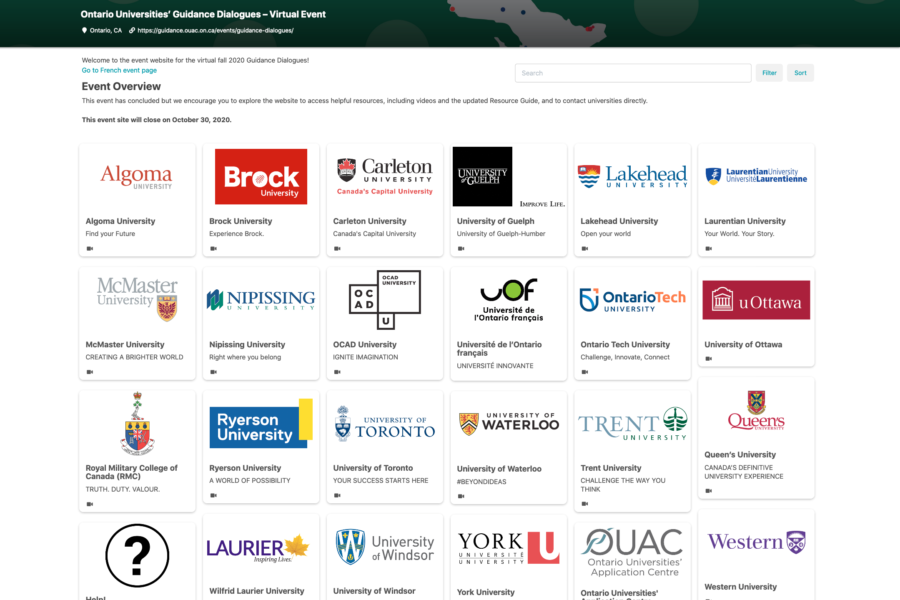We’ve done many academic virtual events over the last several months. From Poster Sessions, to Career Fairs, to Teaching and Learning Symposiums, to Virtual Open Houses, all the way to full blown student association conferences. In supporting these events we’ve learned a lot about different best practices. We’ve also had the opportunity to work with experienced event managers and coordinators as well as individuals who had never put together a virtual event before, but deployed an immersive and engaging event in as little as a few days.
In this blog I’d like to share 10 of those learning outcomes and insights with you.
1 – Timing is more flexible online
Scarcity of physical event locations means space is expensive and can only be made economical by planning events to a much tighter timeline. This narrow space of availability also plays a factor in how many attendees you can draw, how many speakers are available, and more importantly how tightly you have planned out your event.
Online events do not have the same physical limitations of space & time since there is an unlimited amount of space that can be created online for events and this space can be spread over time because attendee’s travel time is reduced to nearly zero. This means that in the virtual world, events can take place over days, weeks, or event months. Event organizers can allow events to ‘breathe’ and don’t need to jam pack a week’s worth of content into a 2 day window. This also means event organizers can reduce the density of events and make them less stressful and more convenient for attracting attendees, vendors, and speakers. It also allows attendees to better consumer the event in its entirety versus having to make trade-offs between components because of overlapping schedules or schedule conflicts.
2 – Think of each virtual event in 3 separate stages: Pre, Live, and Post
In physical events, the primary focus is on the live component of the event, and the pre and post elements are mostly seen as setup and tear down of the venue. In the online event world, you can add incredible value to an event by putting some thought into the pre-event and post-event experiences. We have observed how many event organizers have extended the reach and engagement with their attendees by reframing their view of the entire event through these three lenses.
The pre-event gives you an opportunity to onboard attendees and become involved with the event by providing access to content that can help them better prepare for the event, this can be pre-recorded video or documents. This information can help better set the stage for the main event and give attendees more value out of the live experience. For example, you could open up virtual poster sessions for attendees to explore, this gives them more time to digest information and to be more deliberate around which individuals they want to have discussions with during the live event. Another example is making them aware of networking and talent zones planned for the event that may require them to publish a profile or digital portfolio for like minded researchers or potential employers.
The post event is the part that excites us the most. Since live sessions can be recorded, you can actually give attendees a way to relive the event. In online events you don’t have to miss out on an important speaker because it is at the same time as another session you prioritize to attend, or because you are unable to make it because of a prior engagement. This also gives event organizers the ability to turn live events into on-demand events, creating a brand new potential revenue stream for organizers.
3 – Make smart Synchronous & Asynchronous Choices
When thinking about physical events, virtually everything has to be thought about in a synchronous framework. Online events offer greater possibilities for asynchronous content that are not bound by time and space. For example, in physical poster sessions, poster creators have to stand in front of their poster and explain their research to individuals as they pass by. In the online world poster creators can actually shift a lot of this synchronous content into asynchronous content, for example by recording a short 5 minute video that explains their poster and making it available on demand to everyone who visits their virtual poster. This creates an environment for much deeper conversation in the live online video meetings and also enables a researcher to handle a greater volume of interested parties, with the video and ancillary content answer the typical discussions.
This ability to shift content to an asynchronous framework also makes planning content for your event much easier. Do you have a speaker that would be perfect for your event, but they are already booked? No problem, you can have that speaker pre-record a session and make it available in your event. This asynchronous ability effectively means your event is available 24 hours a day, thus creating incredible opportunities to be far more convenient for attendee’s schedules. We also see most organizers prefer to work with pre-recorded talks to mitigate the risks of attendees or speakers having faulty internet connections and leave Q & A to the live component.
4 – Focus on a Simplifying the Attendee Experience
It’s a brave new world as most events are transitioning online. One of the biggest areas of concern with virtual events that we’ve heard is that a lot of people find the navigation and layout of many virtual events are confusing and not intuitive. It is not uncommon for individuals to interact with several different virtual online events within a month of each other. This can become overwhelming to learn how all these different platforms work especially considering the wide range of features different platforms offer. For this reason we have found that it is really important to carefully plan and design your venue to be intuitive and simple for your attendees to navigate.
You shouldn’t have to send attendees an email explaining to them ‘how to navigate’ the event. They should be able to drop into the event and feel comfortable that they know what they need to do within the event immediately. This means a well thought out, simple and easy to navigate event structure should be a focal point of the planning process. Based on feedback we’ve heard from attendees and event organizers, it is better to host a simple event, that is easy to follow and use, than a featured-filled event that is convoluted.
5 – Have a hard linked Schedule / Agenda
A good schedule/agenda is a foundational piece of a well organized in-person event. Many people are used to relying on these core documents as a way to navigate an event, and as a way to mentally understand how they want to schedule their time and priorities at the event. We have seen that many event organizers have dropped the use of these documents and instead moving to a website based version of the document. We have found this to be inconvenient and awkward for attendees to easily consult with it. We highly recommend taking the same approach for your schedule/agenda as you did for your live in-person events. Although you may not be able to print out the booklet for individuals, it is effective to be able to provide it to them virtually via a PDF in a central location in the front lobby.
The familiarity of an agenda that looks the way attendees are used to will help them feel more at home in your event. The only modification that we suggest is to enhance the agenda by adding hyper-links between each agenda item to the various areas of where the item is taking place within the virtual event. The PDF standard format allows event organizers to embed links within the agenda/schedule. Attendees find the convenience and simplicity of a quick link to each individual session is an added feature that is easily organized and attendees appreciate.
6 – Plan out in detail how you will enable greater social interaction among attendees
It will be a tall challenge for any virtual event to match the social spontaneity of an in-person event. Natural and unplanned connection is definitely a benefit of in-person events. We have found that for online virtual events, social interaction needs to be facilitated and orchestrated. Luckily for virtual event planners, the pandemic has fast tracked user familiarity with web-calling and conferencing technology such as Zoom, Google Meet, Microsoft Teams and others. However, we have found it isn’t enough to just have access to a Zoom links for people to interact. Organizers need to create clearly demarcated zones that are specially designed for socialization purposes. This helps to communicate the rules of social engagement and also better drives the social / networking goals of the virtual space.
Event planners need to get granular in their thought of how attendees are going to connect with each other and what the experience is expected to look like. They should think through the types of conversations they’d like to take place at their event so they can plan around it and ensure the intended outcome is achieved. For example, if you want attendees to be able to network with each other, you need to clearly define a Networking Zone and whether it is voluntary or not. Within that Networking Zone organizers need to be clear with all attendees the different pathways and communication tools at their disposal to interact with each other, and furthermore what they can expect when interacting in that way. Events that are able to provide attendees with clarity on this have far better engagement in the social elements of their event.
7 – Enabling secure and private sharing from academics is key
Successful academic events, whether in-person or virtual, are all about the sharing insights and ideas and inspiring new ones. One of the issues for many virtual event platforms is that they do very little to enable their attendees to share in any meaningful way between each other. This results in events that are more akin to a website with pre-recorded videos and content, rather than the meaningful exchange of research and challenging conversations that drive deeper insight and thought.
Academic events run on Acadiate, have exceptional good feedback and engagement, because our foundations are in “Helping People Showcase Themselves in the Digital World. That means every attendee, by default, has a wide array of communication tools they need to publish and drive deep engagement around their work. Whether it is in a Networking Zone, a Poster Session, Activity Tables, Research Sharing and more, peer-to-peer interactivity is essential to strong experiences and unfortunately where most virtual academic events fall short. Whether you are using Acadiate for your virtual events or another platform, you’ll want to make sure that you empower your attendees to participate in meaningful ways, privately, and securely.
8 – Excellent support isn’t a nice to have, it is essential
There are a lot of fears for event organizers to move online because of their lack of experience and how quickly the space has developed. Technology can be intimidating for many event organizers who are not technologically inclined. In the physical environment this isn’t a problem, event organizers are quick on their feet and can quickly come up with great solutions for most problems. Unfortunately in the virtual world problem solving is usually more technical and most event organizers do not have a computer science degree. This means it is paramount to work with a virtual event company that understands your events, your audience, and the vision you want to execute with your virtual event.
One of the greatest strengths at Acadiate is our background in academia. We’ve been working closely with academics and in Higher Education for 10 years now and understand the realities facing academics and students. We are able to leverage this experience to support virtual events in ways that work more naturally and intuitively for academic administrators, faculty, and students. We’ve structured our events so you don’t have to add any workload to your existing IT infrastructure and individuals with zero web development or design experience can organize and execute world class virtual events, quickly and easily.
9 – Use a central spreadsheet for event organization
There are loads of new and exciting collaboration tools. However we’ve found that there isn’t a better tool to organize virtual academic events than spreadsheets. We use a custom formatted spreadsheet to help each organizer plan their events and to organize all the event digital assets in one place to ensure they are well organized, but is also an effective centralized communication tool between the event organizer and the event platform venue. One of the unique aspects of Acadiate academic virtual events is each event can be custom designed to deliver very targeted user experiences and in many cases may need to be reconfigured or modified at any time. In many cases, organizers have last minute requests from sponsors or a new idea they want to implement, even after the event has gone live.
This isn’t because spreadsheets are the most feature rich or that new technologies aren’t up to par, it’s simply a matter of the learning curve. It’s stressful enough to have to consider moving an event online, having to learn a new way to collaborate for event planning can add an unnecessary layer to this. Most people understand and are comfortable with spreadsheets for organizing information and so we prefer to work with the most common tools everyone works with everyday.
Almost every academic we know understands spreadsheets well enough to use it efficiently for event planning. We have found that planning events out through a spreadsheet first makes transitioning the plan into a virtual event much faster and it results in events that are more cohesive and flowing in structure. A central spreadsheet also allows you to easily get more hands on deck for event creation. The vast majority of the events we plan are planned and built in less than 3 days.
10 – Well defined welcome and closing messaging
Most event planners have a welcome message in their plans. This welcome message provides attendees with a greeting, but also provides context and direction for what to expect from the event. It can be an important orientation point for attendees to get themselves in the right headspace for the event. However while most event planners are very clear on the welcome message, most do not put much thought into the closing message.
We suggest that every event has a defined closing message planned for individuals. The closing message should provide attendees with a brief recap of the event, the value it provided them, a thank you, and clarity on how they can potentially interact with the virtual event after the live component has ended. This is especially useful for events that have content that can be consumed in the weeks to months following the event. In a live event there are always closing remarks, but in addition to that, attendees can pick up on the important social cues of seeing other attendees packing up and leaving the event. In the virtual environment, attendees don’t get those social cues and will rely on direct communication for a sense of closure for the event.
We believe that we are still on the ground floor of the benefits of virtual events. When we initially started going down the path of running academic virtual events we did so thinking it would serve as a quick solution that would enable our partners to remain functional virtually until they could return to their events in the physical world. What has surprised us is how many benefits have emerged such as cost savings, vastly expanded event reach, better scheduling, ability to record and relive events as a library or repository, etc. While there are some ways virtual events cannot match in-person, physical events, the benefits are strong enough that almost all of our partners have told us that even after they are able to return to in-person, physical events, that they want to continue with a hybrid approach that includes a virtual component because of their immense utility.
I am hopeful that this list provided you with some insights into what we have learned in supporting academic virtual events. If your school is interested in running a virtual event please don’t hesitate to email us at [email protected].






